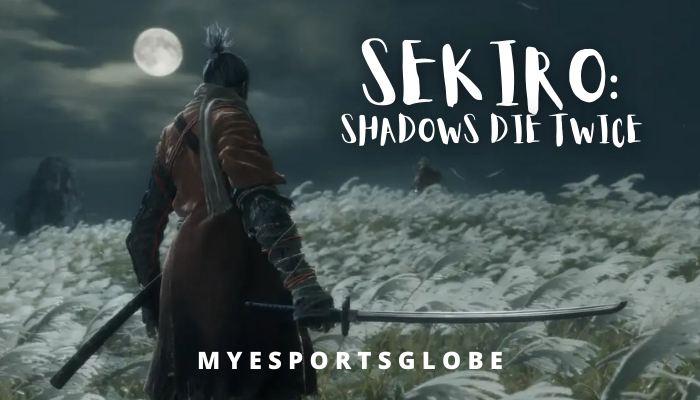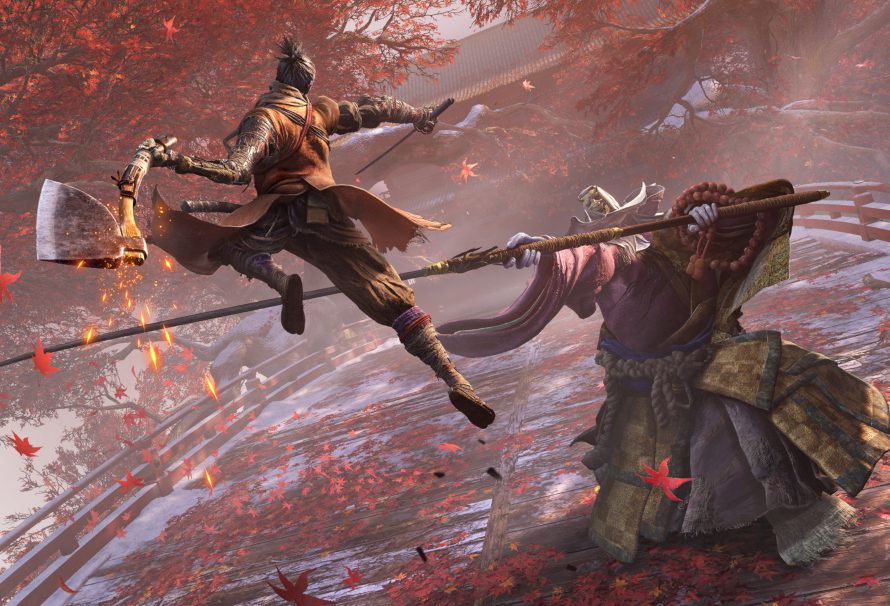

Sekiro: Shadows Die Twice is an action-adventure video game developed by From Software. The game, in which a shinobi is controlled from a third-person perspective, was released worldwide on March 22, 2019 for Microsoft Windows, PlayStation 4 and Xbox One. The scenario of the fantasy game is based on the Sengoku period of Japanese history.
Rather, it is a breath of fresh air for Souls fans and food for everyone who thirsts for a merciless (!!!) challenge. And here we come to the first assertion of my not entirely serious introduction, the lie. As the title suggests, shadows don’t just die twice.
When cult developer From Software announced their new title at the Game Awards 2017 by means of a mysterious teaser called “Shadows Die Twice”, many rumors grew up about a second part of Bloodborne. But at E3 2018, the Japanese finally unveiled their new work, including a feudal Japanese setting and surprising collaboration with publisher Activision as Sekiro: Shadows Die Twice.


Originally conceived as a new offshoot in the Tenchu universe, whose license holder is From Software itself, Sekiro ultimately developed so much life of its own that it became an independent game. Since March 22nd, Shinobis can now face the new challenge from From Software on PS4, Xbox One and PC. Find out why Sekiro has become more than just another Dark Souls and probably already one of the titles of the year.
You play Sekiro in a fictional Japan at the end of the 16th century. As a shinobi, who is also called one-armed wolf, you have the honorable task of protecting the young Kuro with your katana Kusabimaru.
The special thing about Sekiro, he can’t die, well almost. You have the opportunity to revive yourself once and continue to fight with half your life bar. The direct second death, however, means waking up again at the Buddha statue. The Buddha statue function should look familiar to many Souls fans, because this is the beacon in Sekiro: Shadows Die Twice.
Here you can e.g. Travel, upgrade things, replenish your life energy. It’s not the only thing that resembles the Souls series, by the way. E.g. When resting at the statue, enemies are revived; dead enemies give you points with which you can buy new skills. There are hardly any RPG elements left, you only have one weapon and you cannot create special builds. Nevertheless, the gameplay loop offers motivation to upgrade Sekiro’s abilities and acquire new active and passive skills / improvements. Taking care of mini bosses and searching the world is also rewarding, because you will find special items that make Sekiro stronger.
Another great help on your adventure is the prosthetic arm. With the built-in grappling hook you have the opportunity to explore the vertical, so you can sneak past enemies and then kill them from behind. But there are also useful modifications for direct combat, such as fireworks, this unsettles your opponents for a moment, which is particularly useful for bosses. During the game you will find several such Modifactions and you can then improve them.
This time you don’t have to put together the story from cryptic conversations or item descriptions, as is typical of FromSoftware. Instead there are cut scenes in which the story is told. Nevertheless, some things remain unclear and in order to find out more about the world, you have to listen to NPC conversations or find items as usual.
The fighting is primarily against human warriors. From the small sword swinger to the nimble monk to the huge head samurai, everything is included. Your opponents usually patrol the areas of the game world individually and in small teams or are permanently stationed at certain points.
You will also meet fantastic characters from Japanese mythology, for example ogres. In essence, Sekiro is set at the end of the real Sengoku era in Japanese history, but it plays with all sorts of supernatural beings in a kind of parallel universe.
Sekiro: Shadows Die Twice, won’t win the title of best graphical PS4 game, but it doesn’t have to. Because on your journey through fictional Japan, the game manages to perfectly capture the atmosphere, be it sound, surroundings or boss design. The fights are also great, starting with the skills that conjure up nice effects on the screen. Right up to the perfectly hit sound when your katana parries an enemy attack or you take a fatal blow.
With the sound, however, the Japanese have done a great job again: The soundtrack is clearly based on its setting and offers beautiful Far Eastern, but also exciting and epic sounds, which in combination with the powerful effects provide an incredible amount of tension during the fights. With the dubbing you have the option of choosing the Japanese original or the English version. Apart from that, Sekiro has no dropouts in terms of control and delivers a convincing job: Fights go smoothly after the familiarization period and any errors, injuries or screen deaths are due to personal debt.
In terms of the story, Sekiro starts in feudal Japan of the Sengoku era and combines historical elements with a lot of myth: As an orphaned boy, a merciless samurai takes you as his foster son and trains you in the martial arts of the Shinobi. Years later known as Okami – the wolf – you are the protector of the young emperor Kuro, the last heir to the Dragon Bloodline. When the boy was captured in your absence, you manage to save him, but you are caught by the leader of the Ashina clan and lose your arm and Kuro himself in the fight.
When you are in a dilapidated temple with a wooden prosthesis on your arm wakes up, the typical developer journey begins into a mysterious world that is the narrator of the story itself and offers all sorts of crazy and interesting NPCs. But unlike in the spiritual predecessors Dark Souls and Bloodborne, this time you will also be accompanied by a framework with a fixed character and cutscenes, which comes across as pleasant and creates a certain arc of suspense.
Because Sekiro remains at the core of one thing: merciless! The level of difficulty is like in every other title of the Soulsborne genre simply hardcore, does not forgive mistakes and teaches you the patience and mindfulness of a Shinobi the hard way. This time, however, instead of a freely manageable point system, Wolf gets his own talent trees, which unlock active and passive skills and special maneuvers.
You collect experience points as usual by killing and looting the opponents, who by stopping at one of the checkpoints named “Figure of the Sculptor”, which the eponymous sculptor, who is also responsible for the maintenance of your prosthesis, travels in left the world to be revived. In order to get more life or strength in your posture, you have to kill the mini-bosses scattered all over the areas in order to get the prayer beads you need for an upgrade.
In addition to the stealth mechanics, the combat-heavy action adventure offers other attack options. In contrast to the level system of the Souls series, your Shinobi improves Sekiro, among other things, by using experience points in a talent tree. You collect the points like the currency of the game in battle. So until the end of the game you have five branches with active and passive skills.
For example, on the Shinobi Arts Path, you will learn a whirlwind blow that hits multiple enemies at once. If, on the other hand, you choose the path of the Ashina arts, a heavy overhead sword strike will soon be part of your repertoire. At the end of each branch there is always a particularly powerful martial art waiting. How you distribute your precious points is entirely up to you. Once established, there is no going back. So think carefully about which arts should make your life easier.
But well, the game certainly offers other ways and opportunities to survive against the numerous enemies, you say. And yes, there are. Above all the excellent and incredibly satisfying stealth mechanics. So you can – apart from bosses – stealthily sneak up on all opponents or rush down on them from lofty heights to give them a brutal death blow.
If you are skillful, you can turn off most of the enemies in this way and make the game much easier for you. If you are discovered, the tactical retreat usually helps. So you either flee quickly on foot to areas far away from your opponents or use your grappling hook (more on that later) to pull yourself out of reach.
After a while you can start a new attempt on quiet feet. The attention span of the scared is limited. But that shouldn’t be a criticism of the AI. It is first class, fits the game and knows how to defend itself well, depending on the type of opponent.
Also cool: there is an eavesdropping mode. If you sneak up on enemies quietly, you can overhear the conversation between two NPCs from a distance at the touch of a button and thus receive important information about the weaknesses of an opponent or the location of a secret item.
Have you ever had the feeling that a game is too difficult and you don’t want to continue playing? This is exactly what can happen to you in Sekiro: Shadows Die Twice. It is sometimes tough, does not forgive mistakes and there are bosses that you have to pass, otherwise you cannot go on. Here it is important to stay on the ball and to make any improvements that are still open.
Then when you finish the boss there is this feeling that the Souls series is all about, but this is not for everyone. The lack of online mode also contributes to this. Where you could still call for help in parts of Soul to put down a tough boss for two, in Sekiro you have to cope with everything on your own. So quickly frustrated players have hardly any opportunities to advance.
In order to master this new level of difficulty, even for the Souls series, the game offers you a lot of help. The prosthetic arm capabilities are extremely useful and not just a nice gimmick. The new, faster fighting style is also extremely well done and provides a breath of fresh air, even if Souls players will need some time to adapt. Seldom does a game give you more opportunities to feel nimble and like a real shinobi. In addition, the game offers you a motivating system to further improve your character.
Sekiro: Shadows Die Twice is more compact in terms of storytelling and RPG mechanics than its intellectual predecessors, but it turns up a lot in terms of skill requirements and offers you a completely new, exciting and challenging experience that demands everything from you and should not be left out by any friend of well-kept hardcore games. With the exception of the usual camera problems and an idiosyncratic looting mechanism, it is definitely a must-have and one of the contenders for the game of the year.
You can find more of such articles at MYESPORTSGLOBE
Follow our Social media handles for more exclusive eSports News Instagram Twitter Facebook
Trainers in India will be introduced to a splash of colors during the Pokémon GO…
ABOUT SAMURAI SHODOWN Samurai Shodown is a fighting game series by Shin Nihon Kikaku Corporation.…
The Barcelona star striker has retired from Football. Sergio Aguero breaks into tears as he…
Introduction of Tekken 3 Tekken is one of the most popular games in the world.…
History and top 7 upgrades of COD In 2003, Call of Duty (COD) video game…
Legal and Ethical issues in eSporsts “At present competitive gaming is somewhere between a business…
This website uses cookies.